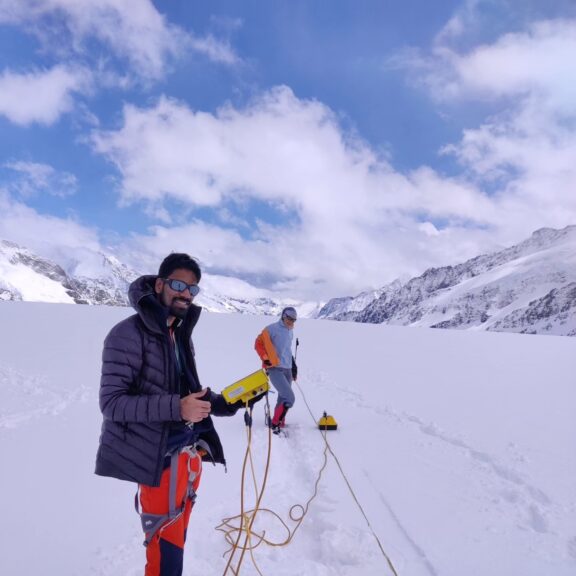As a continuation of the expedition to the Aletsch Glacier in winter 2024, a group of researchers conducted a second expedition in May as part of the M3OCCA program. The group aimed to gather GPR CMP data at three different locations of the accumulation area of the Aletsch Glacier. Snow pits were dug near CMP locations to obtain a density-depth profile at the upper few meters of snow to get the density profile between the visits in March and May 2024. The GPR CMP method provides vital information regarding the Electromagnetic (EM) wave velocity-depth within the firn body of the glacier. The density of the firn body is a function of the EM wave velocity; the obtained density-depth profile aids in the detection and estimation of annual firn layers to study the firn densification rate. This information assists in estimating the mean glacier mass balance by considering the firn density rather than assuming a constant density value for the entire glacier.
This expedition was part of the M3OCCA doctoral program project 2.3 (Improved Glacier volume to mass conversion), and the efforts of Dr. Christoph Mayer and Dr. Astrid Lambrecht from BAdW Munich, Akash Patil (M3OCCA PhD at BAdW Munich), and Manuel Saigger (M3OCCA PhD at the Institute of Geography FAU Erlangen) are much appreciated.

As a continuation of the expedition to the Aletsch Glacier in winter 2024, a group of researchers conducted a second expedition in May as part of the M3OCCA program. The group aimed to gather GPR CMP data at three different locations of the accumulation area of the Aletsch Glacier. Snow pits were dug near CMP locations to obtain a density-depth profile at the upper few meters of snow to get the density profile between the visits in March and May 2024. The GPR CMP method provides vital information regarding the Electromagnetic (EM) wave velocity-depth within the firn body of the glacier. The density of the firn body is a function of the EM wave velocity; the obtained density-depth profile aids in the detection and estimation of annual firn layers to study the firn densification rate. This information assists in estimating the mean glacier mass balance by considering the firn density rather than assuming a constant density value for the entire glacier.
This expedition was part of the M3OCCA doctoral program project 2.3 (Improved Glacier volume to mass conversion), and the efforts of Dr. Christoph Mayer and Dr. Astrid Lambrecht from BAdW Munich, Akash Patil (M3OCCA PhD at BAdW Munich), and Manuel Saigger (M3OCCA PhD at the Institute of Geography FAU Erlangen) are much appreciated.